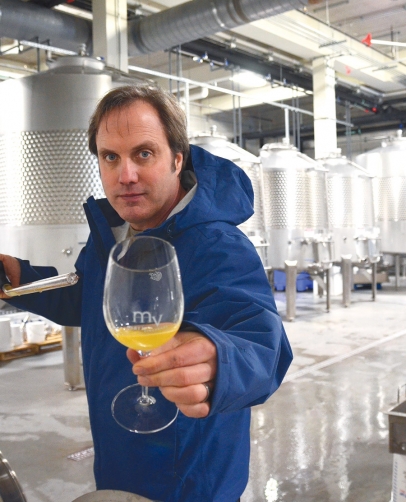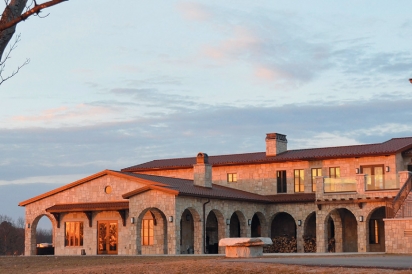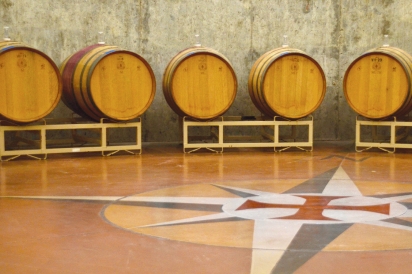Winemaker Sean O'Keefe
When I shared with colleagues that I would be writing about Sean O’Keefe, head winemaker at the recently opened Mari Vineyards on Old Mission Peninsula, I was warned that I would be challenged in the selecting, not the seeking, of interesting nuggets. And so it has been. Thus, I’ve decided to share with you a selection, directly as he spoke them to me. But let me first introduce the protagonist.
In case you haven’t been following the Northern Michigan wine scene, Sean is known both locally and abroad for some of the best wines grown and produced in the Old Mission Peninsula AVA, most particularly his portfolio of Rieslings.
What in hindsight seems remarkably focused was in fact anything but, as he maneuvered toward an acquisition/exploration—or dare I say mastery (he wouldn’t)—of European and New World vinification techniques as well as his personal understanding of Old Mission Peninsula terroir.
“Sean is a blend of humility and mad skills rarely found in the same soul. Usually the ego outshines the product. In his case, the product outshines the ego.”
—Detroit wine critic Chris Kassel
Second son of Ed O’Keefe, who founded Chateau Grand Traverse (CGT) in 1974, Sean grew up in the heart of the region’s infant wineries. He witnessed their successes and struggles in equal measure, as they worked out survival strategies for the challenging weather conditions of this new viticultural region.
This past year Sean moved his winemaking home from CGT to Mari Vineyards. Owner Marty Lagina, engineer, energy entrepreneur (and treasure hunter), has a dual passion for wine and his Italian heritage. To help manifest his vision and dreams for Mari, he enlisted Sean in 2009 to vinify his grapes, and subsequently to assist in choosing grapes to plant, and to design the cellars and equipment of this unique and majestic new winery. Amongst the most unusual conceptions of Marty and Sean are the growing tunnels, trademarked with the name “Nellaserra,” that cover one of the winery’s rolling hills. The tunnels house the grape varieties that require a bit more warmth (up to 10–12 degrees more) at the end of the growing season to come to their full potential, such as Cabernet Sauvignon and Nebbiolo. Open at either end, the tunnels permit airflow over the plants; and, when the vines are dormant in the winter, the tunnels are uncovered.
I met with Sean over a cluster of winter mornings, ensconced in the comfortable sitting area of the Mari Vineyards tasting room, chainmail above the fireplace, laptop keys under my fingers. I listened (having quickly determined that questions derailed his flow) as Sean shared on education, literature, history, winemaking, colleagues, goals and much more.
CHERRY-PICKING AN EDUCATION
Sean finished high school two years early, took courses at NMC in Traverse City, traveled to India, perfected his snowboarding out west, then enrolled in the University of Michigan to study German literature, absorbing Hesse and Goethe as well as many of the Classics and Romantics. Twenty credits short of a degree, in 1994 he headed to Germany to apprentice with his father’s former winemaker, Jakob Pfleger, in the Pfalz. From there, the option opened to attend the University of Geisenheim in Rheingau, a place he dubs “the Hogwarts of Riesling.” Skipping prerequisites, he focused on upper-level viticulture, biochemistry, oenology, etc., all in German.
“The passion was very apparent. I felt this is somebody I have to definitely keep watching.”
—Stuart Pigott, wine critic and author of The Best White Wine on Earth: The Riesling Story, of their first meeting in 2000.
Returning to the United States in 1998, Sean weighed his options: work out on the West Coasts or return to his family’s winery. Choosing the latter, he went to work for his father and the estate’s winemaker, Bernd Croissant, at first “filling in here and there” but taking on more over time. Inspired by all that he had seen and learned in Germany, he took over a corner of his family’s winery and in small batches, explored techniques including gentle whole cluster fermentation and aging on the lees, to craft what were soon to be award winning wines. From here, let’s continue the story in his own, and a few of his colleagues’, words.
I started running the vineyards, making some wine. I wanted to focus on quality, to try things—drier styles—we always made dry Riesling but they can be really sour up here.
My career goal evolved: How do you make dry Rieslings with flavor, quality, range? I was in my own war against entropy. I won the battle for the most part without sacrificing creativity—using the techniques I’d discovered in Germany such as gentle whole-cluster pressing.
IDENTIFY THE GATEKEEPERS AND MAKE THEM YOUR ALLIES
Germany: Little did I know that everyone I was going to school with were future superstars. My best friend became the director of Schloss Johannisberg [one of the most elite Riesling focused wineries in the Rheingau].
Traverse City: The winemakers here collaborate. We give each other advice, gather to taste and share. Though we are competitive on the market, on the winemaking level we do our best to help each other out. We need to.
Not only was I making wine but I love restaurants, I enjoy the pairing. Amanda and Paul Danielson of Trattoria Stella and The Franklin [were] buds from the beginning when they got up here.
[In collaboration with Amanda, Sean cocreated “The City of Riesling,” an event now in its third year, designed for both colleagues and the public, drawing people from all over the world to Traverse City.]
Out of State: I scoped out the most interesting shops and restaurants, understood the system. There’s always a Traverse City connection. All these Michigan somms [sommeliers], we ship them all over, and that opens doors. Before we [CGT wines] knew it we were in all these awesome places in Chicago, New York....
Beyond: I had time and made the most of it, going to the West Coast, going to Chicago, participating in major blind tasting events. I looked outside the norm of local, state and national competitions, focused on the critics and the somms, sought out the European writers.
In 2012, during the blind tasting of the world’s finest dry Rieslings at the Frankland Estate International Riesling Tasting in Sydney, Australia, Jancis Robinson, English wine critic and author of The Oxford Encyclopedia of Wine, wrote of Sean’s 2010 Lot 49, “To my mind this is the most interesting wine by far, a wine I thought might be a wildfermented dry German. I loved the energy, the slightly funky but extremely interesting nose and the fact that it tasted bone dry but had such an impressive array of wild-flower aromas. I would drink it with great pleasure from now for the next five years.”
AT MARI VINEYARDS
In Marty Lagina I find a similar spirit to my dad, the consummate entrepreneur. It’s a once-in-a-lifetime opportunity to design this whole cellar and wine program. And the timing was right. It was time for me to depart CGT and let my brother take the reins there.
Marty’s family is from Northeastern Italy, an area with a climate not too far off from what we have here: Alpine and sub-Alpine regions, where very cold winters are the norm, particularly a hundred, two hundred years ago. Consequently, the grape varieties planted there had the potential to survive a Michigan winter and would ripen in our local climate.
Not only can we plant varieties from there, we don’t need to reinvent the wheel. We can follow the tradition of making blended wines, aiming for complexity and adjusting to the climate.
The tunnels are not just a cool concept—it’s part of the business plan, to extend the ripening season for certain grapes. They prove recognition of the reality of this region. What makes me unique is I am consciously articulating this. The tunnels are strange. But so is drying grapes [a technique used in certain European regions].
It’s a reality that within every decade there will be one or more disastrous vintages. Your business plan should take that into account. Don’t go into it blindly. In ’92 and ’94 CGT and many of our neighbors found a solution and brought in juice from outside. Others have opted to add cherry wine and/or cider to their list. Here, at our new winery, my first priority is to grow the grapes that I think, in most years, are going to do well. I want to make wines from only grapes grown here, not from somewhere else.
Originally, I had thought that at this point in my career I would be focusing my attention on the grapes that I know survive and thrive here, in particular Riesling and Gamay, with perhaps some Pinot Blanc and Grüner Veltliner. But my fate has been determined differently. I can’t complain. There are other things this area can still do, and I’m excited to be part of this. But I can’t deny that I am still surprised to be making a bunch of Italian red and white wines. I never saw that coming.
At Mari Vineyards I have the space to treat each variety and each vineyard to best express itself. Now I have the ideal storage space, barrels and equipment. I’m relieved it’s been a good year. I’m still discovering the potential of our Italians and reds, but I think I’ve got the best group of Rieslings I’ve ever made in my life.
OLD MISSION TERROIR
Terroir is inherent, then there’s the people and the culture factor. On the most basic level there’s something about Old Mission and Leelanau Peninsula. We’re surrounded by water. We’re a continental climate on a narrow little band along the coast of Lake Michigan; a weird little maritime, continental climate. There isn’t anywhere like this. We’re between Lake Balaton and Hungary. We’re obscure and we’re developing on our own, on the edge of things and surrounded by water.
Our soils are predominantly sandy: “Clay” equals sandy with some clay in it. It drains really well, which helps during frost and cold winters. In 2014 and 2015 our vines should not have survived. But that sandy soil meant no root damage. The lake effect and the abundant snow cover protect and insulate. Sand, water and air currents keep the frost off because of the water. Terroir is something you can’t change. The old areas—Europe—are so aware of the nature of their worlds. It’s a fact. You can’t ignore it. You must accept the virtues and limitations.
Whenever the Great Lakes freeze—at least 1½ times a decade—we’re going to have a bad vintage. That’s terroir too. People are always loath to mention it, afraid to make us out to be a difficult region. But we continue to garner awards. We’re distinct. Our wines taste different from everywhere else when they are made well.
PERSONAL PHILOSOPHY
Drier is better; no need to make an inky red, as long as there is structure. Don’t reach for California style. Stick to grape varieties that grow well here, that can survive our winters. Stick with it, and within ten years people will recognize you and the quality you are putting forth. Be good at what you do and work at it.
Vintages in a lifetime: ten for experience. You’re in your mid-30s before you can actually start making all the calls. Then 20 when you’re at the top of your game, then ten more before it might be best to move on.
It takes a lot of beer to make a good bottle of wine.
WEAVING IT ALL TOGETHER
The weaver takes the many strands of his past into the present and transforms them into a cohesive tapestry.
“Every bit as important as Sean’s winemaking skills is how he thinks about wine. He’s changing the professional conversation, not just throwing out quips, but finding a new approach to the subject, aware of the science, yet not spouting it. It is behind his ideas and experiences, to be tested out practically, to push the outer limits of the possible, which for him has been most manifest in his work with Riesling.
“He’s dead serious about it now. He’s not messing around. He’s slightly frightened, but also excited. You stick your neck out that far and of course you’ll have the energy of those shared sensations running parallel.”
—Stuart Pigott
A 2016 TASTING
One late winter morning I was fortunate to taste with Sean from over 23 tanks and casks including six different Rieslings and three Cabernet Francs. The notes here are but a sample of the 2016 vintage, representing some of the newer varietals at Mari Vineyards and including some of those grown in the tunnels.
Troglodyte Bianco: 50% Pinot Blanc, 40% Grüner Veltliner, 10% Sauvignon Blanc. This is the base for the white served at the tasting room entrance: a very citrus vintage, yet with a hint of the classic Michigan apple notes and some pepper from the Grüner.
Grüner Veltliner: From 5-year-old vines. Yellow plums, floral notes, lots of pepper. The aim is not to be heavy on the fruit. For Sean this grape is somewhere between Chenin Blanc, Sauvignon Blanc, Chardonnay and Riesling. It is treated like a Loire Muscadet, keeping the lees in suspension. Not a wine for the fruity drinker, more focused on structure and bouquet, mineral and herbs, with a thicker mouthfeel. To be bottled late early summer for a fall release.
Malvasia Bianca: A strong nose of blood orange and ruby red grapefruit. Mostly dry, not a big fruit bomb though the nose would hint at such. Very grapefruit in the mouth. Exciting new ‘primary color’ for the region. Expected release in May.
Merlot (one parcel): This came in with huge ripeness and flavor, in very toasty oak. Will be added to the Proserpina (Latinized version of Persephone, daughter of the goddess of spring, abducted by the god of the underworld to live with him amongst the dead) along with Cabernet Franc, Cabernet Sauvignon and the dark, brooding Teroldego. High tannin, rich flavor, deep fruit, velvety. From a 4-year-old vineyard, but grown in clay.
Refosco: Dark black raspberries. Highly productive with big clusters, this grape showcases the different structure of the Italian reds. Reminiscent of Gamay, higher acid, red fruits, plums, berry skins, apples.
Teroldego: Dark, rich, to be added to the earlier Merlot to make the Proserpina. Body and warmth, smoke, chocolate, ripe fruit; softer in acid than the Refosco,
Malbec/Syrah: Neutral oak. Syrah is hard to work with here, so this is mostly Malbec. This is Sean’s “reverse engineered Rhone wine.” Very grapey. fresh strawberry jam—a note unique to Northern Michigan for Malbec. Nebbiolo will be added to this. Would go beautifully with fresh goat cheese and lamb.
Nebbiolo: Light in color, like Pinot Noir. To be added to the Malbec/Syrah blend to give it spine. This blend will be the Asa Nisi Masa—nonsense Latin for Anima, life force or soul, a reference to Fellini’s film 8½. For fall release.







